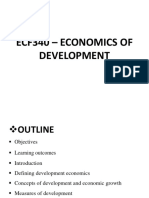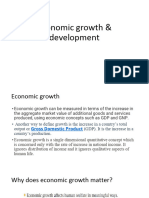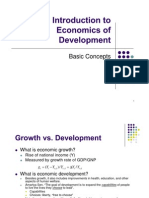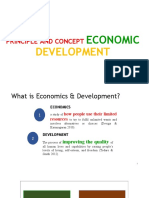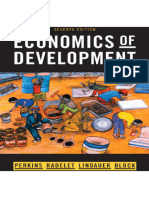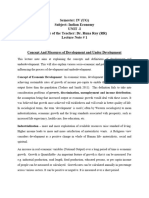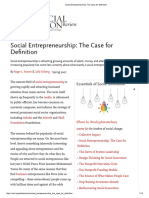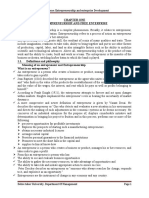Development Economics-1, Unit-1 Notes
Uploaded by
Bhavika KhannaDevelopment Economics-1, Unit-1 Notes
Uploaded by
Bhavika KhannalOMoARcPSD|2511419
Unit 1 developmental economics notes
Development Economics - I (University of Delhi)
Studocu is not sponsored or endorsed by any college or university
Downloaded by Akshay Kumar (akshay0399@gmail.com)
lOMoARcPSD|2511419
Why this change in attitude and sudden interest in development
economics esp. of poorer countries?
● Post the Great Depression of 1930s and the Wars: renewed interest among
economists in the growth and development process.
● Poor countries became aware of their backwardness post their colonial
period.
● Increase in the absolute number of poor and rising inequalities in developing
& poor countries.
● Growing recognition of interdependence between countries: esp. post the
beginning of globalization.
Partha Dasgupta V/S Debraj Ray: On growth and Development
● Economic Development is the process by which a nation improves the economic,
political, and social well-being of its people. It is the growth of the standard of
living of a nation's people from a low-income (poor) economy to a high-income
(rich) economy. When the local quality of life is improved, there is more economic
development.
● Economic growth is an increase in the production of economic goods and
services, compared from one period of time to another. Traditionally,
aggregate economic growth is measured in terms of gross national product
(GNP) or gross domestic product (GDP), although alternative metrics are
sometimes used.
Partha Dasgupta concludes that several factors contribute towards the development
growth path of a nation including Corruption level, HDI indicators, Colonization, S&T
(innovations) and Population growth. He doesn’t differentiate between economic
development and growth. Debraj Ray states that though PCY is only a proxy for
development, there's a high correlation between economic growth and HDI indicators
. He differentiates between economic development and growth.
PRIMARY AND SUB-GOALS OF ECONOMIC DEVELOPMENT
Primary Goal of economic development is to increase the PCY. Debraj Ray has
shown that there’s a strong positive relation between: PCY & L.E for developing
countries, PCY and Literacy Rates and a strong negative relation between PCY and
IMR. But PCY isn’t the only goal because income of the population may rise but
there could be rise in income inequalities too.
Sub-Goals of Development
● Protection of traditional industries
● Specification of a minimum level of consumption
● Focus on nutrition based consumption
● Tolerating only a maximum level of unemployment
● Balanced Regional Growth
● Environmental Sustainability
Downloaded by Akshay Kumar (akshay0399@gmail.com)
lOMoARcPSD|2511419
Can developing countries be categorized into a homogenous
group?
Grouping low and middle income countries as “the developing world” puts countries
such as Malawi (GNI per capita of $250) in the same group as Mexico (GNI per
capita of $9,860). That’s an almost 40-fold difference within the same group. If the
“developing world” classification is being used to group countries with similar
attributes, where people experience similar lives, its use seems increasingly
inappropriate. “Developing countries” are increasingly dissimilar.
GDP (Gross Domestic Product)
Gross domestic product is a monetary measure of the market value of all the final
goods and services produced in a specific time period. It can be measured using
either of the 3 methods; Income Method (addition of incomes of all FOP),
Expenditure Method and Output (value added ). In India, GDP is measured in Market
prices.
Is GDP a good measure of development?
1. One of the limitations of GDP is that it only addresses average income, failing
to reflect how most people actually live or who benefits from economic growth.
2. GDP by definition is an aggregate measure that includes the value of goods
and services produced in an economy over a certain period of time. There is
no scope for the positive or negative effects created in the process of
production and development.
3. Environmental degradation is a significant externality that the measure of
GDP has failed to reflect.
4. GDP also fails to capture the distribution of income across society –
something that is becoming more prominent in today’s world with rising
inequality levels in the developed and developing world alike.
Is GDP a good measure of wealth?
GDP is a flow variable whereas wealth is shadow prices (environmental goods and
services). GDP was originally for market economies. Now by adding notional prices
called “Shadow prices” economists have adapted GDP even in poorer countries
where mostly economic activity is undertaken in non-market institutions (eg: agr. for
self sustenance). GDP is an inappropriate measure of well-being because it doesn't
incorporate some important factors including illegal or black market activity,
environmental activities, in home activities (domestic), and leisure activities. These
all impact the well-being which are not accounted for in GDP.
Downloaded by Akshay Kumar (akshay0399@gmail.com)
lOMoARcPSD|2511419
HDI (HUMAN DEVELOPMENT INDEX)
Definition: The HDI (Human Development Index) is a way to measure well being
within a country. This is mainly a social measurement because it takes into
consideration education, which is adult literacy rate and years of schooling, health
care which is judged by life expectancy and finally the economic factor of GDP. The
HDI measures each of these factors between 0 and 1, one being the best. The HDI
is a very useful measure of development because it includes economic and social
indicators which reduces any anomalies.
A nation needs to be assessed and track its growth to perform well in the coming
days through better ideas providing welfare to its people. Nations production per
year has been taken as a measure to calculate the performance. As the time went
on, gross domestic product (GDP) could not satisfy the proper assessment and
ignored the complete welfare of humanity and turned towards economic growth. The
economists have gathered and prepared a measurement to upgrade the present
system and Human development index was born. This system of calculation is not
an ultimate measurement but a better index to assess the nation's performance. As
the time goes on, there are changes in HDI in order to improve the assessment.The
HDI is a very useful measure of development because it includes economic and
social indicators which reduces any anomalies. HDI consists of three parameters to
assess the quality of life which is referred to as human development and wellbeing.
● Life Expectancy : The term “life expectancy” refers to the number of years a
person can expect to live. New LEI index calculation has come out with
changing its goalposts (minimum and maximum of the life expectancy). For
life expectancy, it has taken 1980-2010 as years which are considered to form
these values. Minimum value for life expectancy is fixed at 20 years in the
new calculation. Maximum value for index is kept at 83.2 years.
● Education or Knowledge availability : Education index assessment is
composite of two indices. They are Mean Years of Schooling Index (MYSI)
and Expected Years of Schooling Index (EYSI). Mean years of schooling
means the spent years by a 25 years or older person in school. The low value
was fixed at 0 and the maximum value is fixed at 13.2. These values are
taken after observation of various countries in the time of 1980-2010.
Expected years of schooling means years that is to be spent by a 5-year-old
boy in school in a country. This assessment of goal posts (Minimum and
Maximum Values) for expected years of schooling is also based on
1980-2010 in various countries. Low value is fixed at 0 and high value is fixed
at 20.6.
● Per capita income of the concerned people of a country: To calculate this
index, Gross National Income per capita is taken as a measure to calculate a
Downloaded by Akshay Kumar (akshay0399@gmail.com)
lOMoARcPSD|2511419
new income index. Minimum income is set as $163 and maximum income is
set as $108,211.
HDI CALCULATION 𝐻𝐷𝐼 = (𝐿𝐸𝐼 𝑥 𝐸𝐼 𝑥 𝐼𝑛𝑐𝑜𝑚𝑒 𝐼𝑛𝑑𝑒𝑥)1/3
0 < HDI < 1
HDI is a geometric mean of LEI, EI and Income Index. As per the values gained,
countries will be placed in the list of divisions of countries. They are divided into very
high human development, high human development, medium high human
development and low high human development countries.
Problems with HDI:
● They only focus on certain aspects of development, social, economic, political
or even environmental. Because of this there tend to be countries which will
rank highly due to part of their country but realistically aren’t as good as
another country.
● It implicitly assumes trade-offs between its components. For example, the HDI
measures health using life expectancy at birth and measures economic
conditions using GDP per capita. So the same HDI score can be achieved
with different combinations of the two. As a result, the HDI implies a value of
an additional year of life in terms of economic output. This value differs
according to a country’s level of GDP per capita.
● The HDI also struggles with the accuracy and meaningfulness of the
underlying data. The HDI does not distinguish between countries with the
same GDP per capita, but different levels of income inequality or between
countries based on the quality of education. By focusing on averages, the HDI
can obscure important differences in human development. Incorporating
inaccurate or incomplete data in an index reduces its usefulness.
● Finally, data on different domains may be highly correlated. For example, the
GDP per capita and the average level of education in countries are strongly
related. Including two highly correlated indicators may provide little additional
information compared to just using one.
PROXIMATE CAUSES OF DIFFERENCE BETWEEN RICH AND
POOR COUNTRY
(Determinants of eco. growth) (Eco. Dev. is a multi-dimensional concept)
GDP per capita is used commonly as an indicator of economic growth. If countries
are arranged according to GDP per capita then we find two clusters, one of rich
countries and other of poor countries. There are middle income countries spread
between these two extremes. Poor countries have a per capita GDP of just 2100$
Downloaded by Akshay Kumar (akshay0399@gmail.com)
lOMoARcPSD|2511419
while rich countries have GDP per capita of about 30,000$. In that sense it appears
that the world is polarized. In addition, there is little sign that the gap between rich
countries and poor countries is narrowing down.
In poor countries there is a vicious cycle of poverty whereas in rich countries there is
a virtous cycle of prosperity. For example for the poor countries people have low per
capita income which in turn results into low saving and low investment, and hence
this results in low productivity which again leads to low per capita income. This
creates a vicious cycle of poverty.
Parth Das Gupta has identified the proximate causes as X factor, Y factor and Z
factor. X factor is physical factor, Y factor is human capital and Z factor is new ideas.
According to him people in r ich countries have better equipment to work with. It
means that rich countries are endowed with more physical capital which is a
significant factor in determining standard of living. In addition, people in rich
countries are better educated implying that they can make use of physical capital to
produce goods. The better educational attainment is indicated by the fact that the
adult literacy rate is above 95% in rich countries. In addition, people in rich countries
are expected to live longer. Taking together the average person in a rich world is
capable of supplying work of higher quality and for many more years. Education and
health are referred to as human capital which is the Y factor. In addition, generation
of new ideas is considered as a prime factor behind economic progress. Rich
countries have become rich because people have been successful in generating
new ideas. It is not only about producing new goods but also about cheaper methods
for producing old products. Therefore, ideas could be considered as the Z factor.
Related to this issue is population growth. There is a two-way relationship between
population growth and economic development. P oor countries are characterised by
high population growth due to lack of education and high mortality rate. Therefore,
we can say that there is no single driving force behind economic growth. All
economists appear to agree that accumulation of manufacturing capital human
capita generation and diffusion of new scientific and technological ideas go together.
For example, if a country has more manufactured capital then productivity of workers
will be high, and society can set aside more of their income for education and health.
As a result, productivity increases further. This is referred to as a virtuous cycle of
prosperity. In contrast there is a vicious cycle of poverty in poor countries.
International Trade, climate and colonization are also determinants of economic
growth in any country.
It is possible to discover the relative importance of various factors responsible for
economic growth. Recently, an important factor has been highlighted by many
economists and it is the factor of institutions. Institutions are defined by established
law, customs, practices, organisations in political and social life. It is also defined by
Downloaded by Akshay Kumar (akshay0399@gmail.com)
lOMoARcPSD|2511419
rules and authority structure that governs the country. The effectiveness of an
institution depends on rules governing it and whether its members follow the rules or
not. The code of conduct in civil service of any economy is honesty, but governments
differ significantly as far as its practice is concerned.
CHARACTERISTICS OF AN UNDERDEVELOPED COUNTRY
● Poverty
● Agriculture: main occupation
● Dualistic Economy: Market economy and subsistence economy
● Misused and underdeveloped natural resources
● Demographic features (very high B.R)
● High unemployment (disguised unemployment around 35% of Labour Force)
● Economic Backwardness (low labour efficiency and factor immobility)
● Lack of enterprise and initiative
● Technological backwardness
● Foreign Trade Orientation (exporting primary goods and importing capital
goods)
● Lack of capital (reason: very low savings rate)
STRUCTURAL FEATURES OF DEVELOPING COUNTRIES
(Characteristics)
Developing countries are characterised by some important structural features
relating to their demographic characteristic, occupational and production structure,
rapid rural-urban migration, composition of trade.
The demographic character of developing countries is that there is a high birth rate
and death rate. But as development proceeds, the death rate decreases while birth
rate remains high. But with faster economic development birth rate also decreased.
In that demographic transition dependency ratio increases for the economy. In
addition, fast population growth reduces growth rate of per capita income. Another
important characteristic is reflected in occupational and production structure.
Agriculture accounts form a significant fraction of production in developing countries.
For the poorest 45 countries the average proportion of output from agriculture is
about 30% and we should note that it includes India and China both. Therefore, a
large fraction of the world population depends on agricultural production. In contrast
the share of agriculture is around 5% in economically developed countries. The
occupational structure in developing countries is almost stagnant showing that the
majority of the population is dependent on agriculture. For example in 1950 the
occupational sector had 60% share from the agricultural sector which was reduced
by only 10% i.e to 50% in 2010.
Downloaded by Akshay Kumar (akshay0399@gmail.com)
lOMoARcPSD|2511419
In addition, there is r ural urban migration which is an outcome of push factor and pull
factor. The push factor from agriculture arises due to extreme poverty and increasing
land lessness. On other hand pull factors are comparatively higher wages in the
urban sector, organised urban sector which provides protection to workers as well as
better standard of living in urban areas.
Developing countries are also characterised by exporter of primary products and
importer of finished products. The traditional explanation for the structure of
international trade comes from the theory of comparative advantage. According to
this theory countries must specialise in that line of production where opportunity cost
is lower. These cost advantages arise due to difference in technology, domestic
consumption pattern and endowment of inputs.
TOT (terms of trade) is unfavorable for developing countries
We must note that emphasis on primary export is not good for developing countries
due to various reasons: -
● Primary products are subject to large fluctuation in world price and this crates
instability in export earnings.
● Over a period, primary products become less important in the consumption
basket. So, an increase in exports is less than an increase in world income.
So, we can say that for developing countries terms of trade is unfavourable.
● Absence of Qualitative Improvement of Products.
● Distribution of Gains from Technical Progress.
● Immiserizing Growth.
● Low Income Elasticity of Demand.
● Impact of Import on the Import- Competing Industries.
● Large Surpluses of Farm Products and a Few Others.
https://www.economicsdiscussion.net/international-trade/terms-of-trade/reasons-for-secular-deteriorati
on-of-terms-of-trade-economics/30362#:~:text=Low%20Income%20Elasticity%20of%20Demand%3A&text
=There%20is%20predominance%20of%20the%20production%20of%20food%20crops%20in%20these%20
countries.&text=The%20increasing%20demand%20for%20manufactured,unfavourable%20for%20the%20
developing%20countries. ( In depth description given in the link)
SUSTAINABLE DEVELOPMENT
Sustainable development is defined as “development that meets the needs of the
present without compromising the ability of future generations to meet their own
needs.” It was popularized by ‘The Brundtland Report’ (1987) entitled Our Common
Future. ‘Earth Summit’ (1992) negotiated and agreed to a global action plan for
sustainable development (Agenda 21). It is focused on Economic and Ecological
dimensions of development. A series of UN conferences after the ‘ Earth Summit’
Downloaded by Akshay Kumar (akshay0399@gmail.com)
lOMoARcPSD|2511419
argued that development is not only about economics and ecology but ‘ social
dimension’ is equally important.
MDGs v/s SDGs
In 2000, the 189 members of the United Nations adopted eight Millennium
Development Goals (MDGs) 8 Goals mostly for poverty eradication (span-2000 to
2015), which were developed in consultation with the developing countries and with
key international agencies, including the WB, the IMF, the OECD and the WTO.
The Sustainable Development Goals (SDGs) are 17 internationally agreed goals and
169 targets to eradicate poverty, fight inequality and improve environmental stability
worldwide. The SDGs aim to mobilise international action over a 15-year period from
2015 to 2030 in a number of areas of critical importance for humanity and the planet,
referred to as the five “P’s”’: people, planet, prosperity, peace, and partnership.
Problems in measuring national income:
Problem of underestimation of income: This is common in developing countries.
There are two main reasons for this: Underreporting (for tax evasion for instance),
and not reporting output produced for self-consumption (mostly in rural areas, where
the majority of the population live in developing countries).
The problem of using exchange rates to measure income: To facilitate comparison of
incomes, each country’s income is converted from the national currency to a
common currency (typically US dollars) by using market exchange rates. The
problem here is that prices for many goods are not reflected in exchange rates. (for
non-traded goods)
The problem of using market prices: In theory, market prices reflect preferences as
well as relative scarcities, therefore they represent the appropriate conversion scale
to use. The problem here is that not all markets are perfectly competitive. Moreover,
expenditure on public goods, valued at market prices may not reflect their true value
to citizens. Also, national income accounts ignore costs of externalities
Downloaded by Akshay Kumar (akshay0399@gmail.com)
lOMoARcPSD|2511419
EXCHANGE RATE AND PPP :
There are two ways of comparing income at the international level: The exchange
rate method and the purchasing power parity method.
Exchange rate method: Each country’s income is converted to a common currency.
An exchange rate is the rate at which one currency will be exchanged for another.
PPP: The PPP exchange rate is that exchange rate that would equalize the value of
comparable market baskets of goods and services between two countries. It is a
popular metric used by macroeconomic analysis that compares different countries'
currencies through a basket of goods approach. Purchasing power parity (PPP)
allows for economists to compare economic productivity and standards of living
between countries.
The exchange rate method suffers from the problem that these rates fluctuate too
much from year to year. Yet, a more severe problem is that prices of many goods
(the nontraded goods, such as infrastructure and several services) are not
appropriately reflected in exchange rates. This is because exchange rates are
relative prices of commodities that cross international borders. The prices of
nontraded goods and services do not affect exchange rates. Moreover, the prices of
such goods are related to the level of development (that is, they are cheaper in poor
countries than in rich countries).
1. A main one is that PPP exchange rates are relatively stable over time. By
contrast, market rates are more volatile, and using them could produce quite
large swings in aggregate measures of growth even when growth rates in
individual countries are stable.
2. Another drawback of market-based rates is that they are relevant only for
internationally traded goods. Nontraded goods and services tend to be
cheaper in low-income than in high-income countries.
According to the Market exchange rate method India is the 7th largest economy in
the world. But according to the PPP exchange rate India is the 3rd largest economy
in the world.
HISTORICAL EXPERIENCE
China’s phenomenal growth: Between 1980 and 1990, China’s PCY grew at an
annual rate of 7.6%. The corresponding figure for 1990-2010 is even higher, around
9.5%.
Downloaded by Akshay Kumar (akshay0399@gmail.com)
lOMoARcPSD|2511419
India’s growth: India grew at a slower rate of 2.6% per year (1960 -1990), but picked
up to 3.6% over the 1990s. Between 2000-2010 grew at a remarkable average rate
of 6.2%.
Growth Rates in Latin America: Languished during the 1980s. 1960 to 1980 it grew
at 2.9% annually. From 1980-90 is the lost decade for Latin America, overall decline
of approx. 10%. Most economies were having negative growth rates in Latin
America. During its 1990s growth in incomes continued to be slow (1.6%) while in
the period 2000-2010 it recovered with average growth rates exceeding 2% annually.
Growth Rates in Africa: Much of Africa stagnated/declined over the 1980s.
Sub-Saharan Africa as a whole declined at an annual per capita rate of over 1%. In
2000-2010 the SSA grew at 2.2%. Kenya barely grew in terms of per capita terms in
the 1980s and continued to decline in the 1990s before recovering to some extent in
2000-2010. Overall growth over the last 30 years has been near stagnant. Uganda:
stagnated over the 1980s (-0.1%). Thereafter picked up some pace and made
substantial progress over 1990-2010 (over 3.5% annually). Rwanda: crippled by
negative growth in 1980s (-1.2%) and 1990s (-0.7%) before a huge recovery in
2000-2010 (4.8%). Zimbabwe was stagnated in the 1980s (0.7%) and 1990s (-0.3%)
before entering a freefall of its own (4.8%) over 2000-2010.
OECD: 1970-1990: OECD growth was over 2.4% annually, 1990s: fell to 1.8% (a bit
more than world average back then), 2000-2010: fell to 0.8% (effect of 2008
subprime loan crisis).
USA: Mirrors the OECD, 1970-1990: 2.2% p.a., 1990-2000: Little under 2.2 % p.a.
Conclusion: Latin America: the sovereign debt crisis. Sub Saharan Africa:
low/negative growth history mostly due to unstable government, civil strife,
consequent infrastructural breakdown and high rates of population rise. East Asia:
farsighted government intervention, a relatively equal domestic income distribution
and opening up of their economies before other Asian economies.
Over the period 1960 to 1985 the richest 5% of countries averaged per capita
income was about 29 times more than the poorest 5% of countries (Parente and
Prescott). This suggests that the entire distribution has remained stationary, but we
find that there is upward mobility as well as downward mobility. To examine that
mobility, a mobility matrix is used.
MOBILITY MATRIX
MOBILITY MATRIX is a way of finding out whether a country has transited from one
category to another category. It is used in order to show changes in the relative
position of countries. In this mobility matrix we convert all per capita income to a
fraction of world per capita income. For example, if country A has per capita income
of Rs.1000 and world per capita average is Rs.2000, then we give country A index of
½. In the case of no mobility, the main diagonal will have entry of 100. When every
box has the same entry, then it implies that each country has equal probability of
moving from one category to another and that will indicate high mobility. Period of
Downloaded by Akshay Kumar (akshay0399@gmail.com)
lOMoARcPSD|2511419
study: 1962-84 (Summers-Heston data set used). If diagonal elements are large it
implies there is low mobility of income. For entries below diagonal, there’s
downward mobility. For entries above diagonal, there is upward mobility.
KUZNETS CURVE:
Kuznets curve graphs the hypothesis that as an economy develops, market forces
first increase and then decrease economic inequality. Kuznets' inverted-U
hypothesis implies that economic growth worsens income inequality first and
improves it later at a higher stage of economic development.
A Lorenz curve is a graphical representation of income inequality or wealth inequality
developed by American economist Max Lorenz in 1905. The graph plots percentiles
of the population on the horizontal axis according to income or wealth.
Causes for Rising inequality with development:
● Transition from Agriculture to Industrial economy (structural changes)
● Lack of jobs in formal sector of economy
● Emergence of entrepreneurs with technological advancements
● Urban biasedness by governments
● Rising inequality: rising inequality include technological change, trade, foreign
investment, the growth of the service sector, welfare state retrenchment, the
growth of wealth accumulation, in particular through capital gains, changes in
taxation.
Causes of Reduction in inequality with development:
● PCY of the highest income group falls over time (esp. due to their share of
income from property falling with time)
● Rise in PCY of lowest income groups (result of welfare measures of
governments: education, health etc.)
THE WELLBEING OF THE WORLD
(ANGUS DEATON)
MEANING OF WELL-BEING
Well-being to refer to all the things that are good for a person, that make for a good
life. Well Being includes material well-being (income and wealth); physical and
psychological well-being (health and happiness); and education and the ability to
participate in civil society (through democracy and the rule of law). It is a wider and
broader term than development.
The greatest escape in human history is the escape from poverty and death
(certainly you can’t escape death, but you can escape death in early age). Over a
Downloaded by Akshay Kumar (akshay0399@gmail.com)
lOMoARcPSD|2511419
period, poverty has reduced as well as mortality rate has reduced. But reduction in
poverty and mortality is not uniform across the world.
HEALTH AND WEALTH
Health is the obvious starting point for an enquiry into wellbeing. This is because we
need a life to have a good life. Poor health and disability limit the capability to enjoy a
good life. However, health is not just a matter of being alive, and living a long time,
but of living in good health.
Statistical value of life, DALY (Disability adjusted life years), QALY (Quality adjusted
life years Health) Health economics are the measures given by WHO to measure
quality of life/wellbeing. It’s about living in good health (removal of malnourishment,
underweight, disabilities, reduction of Infectious diseases and reduction of chronic
diseases).
Good health has many dimensions and is difficult to measure them. However,
People in rich countries report less pain and less disability than people in poor
countries. Disability has been falling over time in rich countries. IQ scores are rising
over time. From this it follows two differences in health are mirrored by differences in
material living standards.
The link between life expectancy and poverty, is far from exact. For Example, China
and India, with life expectancies of 73 and 64 years, respectively, many people live
on less than a dollar a day. There are also some rich countries that do much worse
than their incomes warrant (required). For example, the United States, whose life
expectancy is one of the lowest among the richest countries (Basically correlation
between income and life expectancy is weak). H igh life expectancy, good health,
absence of poverty, democracy, and the rule of law are among the features that we
would include in order to design an IDEAL COUNTRY.
With increase in the GDP per capita, life expectancy is rising rapidly among
low-income countries and it increases at a diminishing rate among rich countries. It
shows that there is a positive relation between GDP (per capita) and life-expectancy.
An important feature of the graph is the “hinge point” near China where the curve
begins to flatten. The hinge point marks the e pidemiological transition. For countries
to the left of the transition, infectious diseases are important causes of deaths, and
many of the deaths are among children. However, to the right of the transition, as we
move to the richer countries, child deaths become quite uncommon, and most
deaths are of old people, who die not from infectious disease but from chronic
diseases.
Life expectancy and incomes are positively related, and it is important for thinking
about the worldwide distribution of wellbeing. Health and wealth are two of the most
Downloaded by Akshay Kumar (akshay0399@gmail.com)
lOMoARcPSD|2511419
important components of wellbeing. However, the above description does not clarify
whether it's higher income that causes better health or whether it is poverty that
causes poor health. It is sometimes argued that there is no relation between income
and life expectancy among better off countries of the world. For example, USA
material living standards are improving in most countries of the world, but it does not
guarantee that there is an automatic link between growth and reduction in global
poverty. It might be that the poorest countries in the world are not growing at all; as it
was true in most of African countries during 1980’s and early 1990s. Therefore, it
has been argued globalization and economic growth are benefiting only rich
countries. As a result, we do not find any convergence between countries. In fact,
there is divergence between rich and poor countries. Well-being also depends on
emotional well-being which indicates a measure of happiness.
GNP V/S GDP
GDP measures the value of goods and services produced within a country's borders,
by citizens and non-citizens alike. GNP measures the value of goods and services
produced by only a country's citizens but both domestically and abroad. GNP is a
better measure of National Income as it accounts for investments returning to the
country on the long run but data is better available for GDP. Hence GDP is
frequently used. Both GDP and GNP are two of the most commonly used measures
of a country's economy, both of which represent the total market value of all goods
and services produced over a defined period. There are differences between how
each one defines the scope of the economy. While GDP limits its interpretation of the
economy to the geographical borders of the country, GNP extends it to include the
net overseas economic activities performed by its nationals. GNP Adds NFOA
(remittances etc.) and so it gives a better picture of a country’s growth. GNP need
not always be greater than GDP .eg: Germany has less NFIA, even though GNP is
much smaller than GDP.
The long answer is neither, these measures are misleading because it tells us
nothing about the sustainability of the grow. Resources depletion and environmental
degradation are completely ignored.
Downloaded by Akshay Kumar (akshay0399@gmail.com)
lOMoARcPSD|2511419
AWAKENING GIANTS, FEET OF CLAY:
ASSESSING THE ECONOMIC RISE OF CHINA AND INDIA
(PRANAB BARDHAN)
China and India are Awakening Giants of the world whose population exceeds more
than 2.5 billion people. In both China and India economic reform started in the
1980s. In China it largely started in the form of experiments by some local farmers
and conniving administrators. In 1978–1979, some farmers in Anhui province started
testing the waters of the existing commune control over land use and effectively
launched a movement of taking over land use as a private right of farmers. This
spread very fast among farmers in neighbouring villages and provinces, and within a
few years the administration rationalized this evolving system all over China as what
came to be called the h ousehold responsibility system, essentially a contracting
system with individual farm households on their land use, subject to taxes and
procurement of produce by the authorities. As Lin (1992) points out, agricultural
output grew at an annual average rate of 7.1 percent during 1979–1984, compared
to 2.7 percent during 1970–1978. This included the effect of growth in traditional
grains and the new freedom to reallocate land and labour to higher-valued non grain
crops.
The reforms in the non-agricultural sector initially followed the same principles as in
the agricultural sector. Apart from some contractual delivery to the state, industrial
and commercial enterprises were given residual control, which boosted production
incentives. This dual-track system, combining elements of both the earlier plan and
the new market systems, operated even without a change in the state ownership of
the enterprises. Thus, this reform, by keeping some of the vested interests
untouched at the initial stages, minimized the resistance to reform.
By the mid-1990s the two tracks were unified in favour of the market. The other
reform was the increasing leeway given to collective, private, and foreign-invested
firms. Through both reforms, market orientation of the economy grew by leaps and
bounds. From near-zero amounts at the beginning, FDI in China increased
massively to become in time the second largest inflow to any country in the world
economy. The most dynamic part of the Chinese economy in the first two decades of
reform were the t ownship and village enterprises (TVEs), largely under the control of
local governments, which provided the leadership in the labour-intensive rural
industrialization of China. From less than 6 percent of gross domestic product (GDP)
in 1978, TVEs’ share climbed to 26 percent by 1996. But unlike state-owned
enterprises (SOEs), they were not coddled or subsidized by higher-level
governments; failing TVEs were often not bailed out. In any case, the lower-level
governments or rural credit cooperatives often did not have enough financial
resources to bail out failing TVEs, even if they wanted to do so.
Even though collective and private firms were the mainsprings of growth, there were
important reforms that made SOEs leaner and more productive. In the 1980s,
Downloaded by Akshay Kumar (akshay0399@gmail.com)
lOMoARcPSD|2511419
analogous to the household responsibility system in agriculture, regional and local
governments experimented with different kinds of “managerial responsibility
systems,” by which SOE managers often signed performance responsibility contracts
and were given more autonomy in decisions, financial incentives tied to enterprise
performance, and profit retention for investment and worker bonuses. In some
cases, SOE managers were selected by local governments through competitive
auctions of commitments to profit delivery.
All these reforms were associated with a high rate of growth in industrial output and
total factor productivity. Industrial output grew at an annual rate of 9.3 percent
between 1978 and 1993, and at 11 percent between 1993 and 2004. Total factor
productivity (TFP) in industry grew at the annual rate of 3.1 percent in the first period
and at twice that rate in the second period. China is now widely regarded as the
manufacturing workshop of the world.
Although growth of exports and FDI in China contributed to employment expansion,
technological and managerial upgrading, and disciplining of hitherto coddled
inefficient enterprises, exports and FDI have not been the main driver of economic
growth. Their direct net impact on GDP growth has been quantitatively modest
compared to that of domestic investment or consumption.
In India, after some deregulation of industry and trade liberalization in the 1980s, the
pace of reform accelerated in the 1990s and afterward, involving abolition of most
licensing of industry, most other restrictions on entry or capacity expansion for large
firms, and quantitative restrictions on trade and exchange control; substantial scaling
down of import tariffs and restrictions on foreign investment in most economic
activities and significant lowering and restructuring of direct and indirect taxes.
The proportion of total trade (exports plus imports of goods and services) to GDP
went up from about 16 percent in 1990–1991 to more than 45 percent in recent
years in India. In China the rise has been much larger, from 21 percent in 1982 to
more than 65 percent. In terms of simple average applied tariff rates, India’s rates
are still about twice China’s, and India’s anti dumping measures, some of them
aimed against imports from China, have been among the most protectionist in the
world. Nevertheless, the integration with the world economy has brought to India the
discipline of market competition and associated firm reorganization, some foreign
capital to many sectors (although the amount of FDI in China, even excluding
“recycled” domestic investment, has been many times that in India), and some
prominent acquisitions by Indian companies abroad that hit the headlines.
It is, however, very likely that the reduction in controls and regulations and the
increased leeway of market discipline and forces of competition may have unleashed
entrepreneurial energies in both the formal and informal sectors and also forged
additional links between the two sectors—links of subcontracting and consumer
Downloaded by Akshay Kumar (akshay0399@gmail.com)
lOMoARcPSD|2511419
demand initiated by the formal sector. But the relatively low levels of education of
workers and of female labour force participation, in addition to weak infrastructure,
act as a damper on India’s growth, particularly compared to China.
The most significant growth in India was in the service sector; TFP in that sector
grew from an annual average of 1.4 percent in 1978–1993 to 3.9 percent in
1993–2004. G rowth in India has been described as service sector–led, whereas in
China it has been more manufacturing-centred. One immediately thinks of the widely
acclaimed performance of Indian software and other IT-enabled services. But it
seems that in India’s service sector not all the growth in the period 1993–2004 can
be explained by finance, business services, or telecommunications, where reform
may have made a difference.
For various reasons, India has not yet succeeded in a massive expansion of
labour-intensive manufacturing jobs of the kind that has transformed the economies
of China and Vietnam. Reason: Most people agree on the problems of inadequate
long-term finance for small firms and of infrastructural deficiencies in India. Many
economists and businessmen also point to the debilitating effects of two
long-standing policies in India: one relates to the reservation of many products for
small-scale industries and the other to rigid labour laws. Neither policy is found in
China or Vietnam.
In one-way Chinese economic reform is quite distinct from that in most countries,
including India. The institutional foundations of Chinese reform have taken the form
of regional experimentation and regional competition. This experimental approach
has served China very well, diffusing political resistance to reform and convincing the
undecided, in addition to updating the initial ideas of the reformers in a world of
uncertainty. But this approach would not have worked if China had a less
decentralized system.
But regional decentralization is much more extensive in China and the vertical fiscal
dependence of the regions on the national government is much less than in India;
the national government is much less involved in local ventures (and therefore local
failures), and the local governments have to take much more responsibility in China,
leaving a lot of scope for local experimentation. India has much more of a top-down
fiscal system. One possible pitfall of local autonomy and decentralization is that local
governments may opt for local protectionism and barriers to interregional integration.
This has not been absent in the Chinese case.
No discussion of China and India can avoid the issues involving the two-way
interrelationships between democracy and development. I n particular we shall
suggest that democracy unleashes both positive and negative forces for
development, that there is some tension between the participatory and procedural
aspects of democracy in matters of governance as well as economic management,
Downloaded by Akshay Kumar (akshay0399@gmail.com)
lOMoARcPSD|2511419
and yet that authoritarianism is neither necessary nor sufficient for development. In
India the large proportion of the poor in an assertive electorate has not always
succeeded in focusing the attention of the politicians on the sustained
implementation of programs to alleviate mass poverty or to deliver basic services
such as education and health care. A heterogeneous society, riddled with social and
economic inequality and conflict, makes collective action for lasting change difficult
to organize and raises populist hindrances to long-term investment and reform. In a
more homogeneous and less conflict-ridden society, China’s leadership can be more
decisive and purposeful in pursuit of economic reform and long-term strategy, but in
the absence of institutionalized checks and balances and of a rule-based system,
there is a certain fragility in governance even in an otherwise strong state, and a
danger of heavy-handedly overreacting to crisis situations and going off the rails.
The decentralized governance structure, which has been a key to rural
industrialization in China, has, in the absence of effective mechanisms of democratic
accountability, limited the power of the central government to rein in local officials
from indulging in capitalist excesses in alliance with local commercial interests. In
India, local democracy and self-government is still inadequately developed: regular
elections at the district level and below are not followed up by effective accountability
of government to the local people in most areas and the delivery of essential social
services and local public goods continues to be dismal. There are accountability
failures in both countries, though their political contexts are different.
Both China and India have made remarkable economic progress in the past quarter
century, but both have severe structural and institutional problems that will
hobble them for many years to come (even after the current problems owing to the
global economic downturn have subsided). Between the two countries, China’s
economic performance has been on balance much better than India’s, particularly in
rates of economic growth and industrialization, in mass poverty reduction, and in the
development of physical and social infrastructure. India’s fiscal health is much poorer
than China’s. China in recent years has had a small budget surplus, whereas India’s
budget deficit is currently more than 10 percent of, one of the highest in the world.
Public debt in India is as high as 75 percent of GDP, while China’s is about 17
percent. The financial infrastructure, however, is weaker in China. China’s future
growth will hit the demographic barrier much sooner than India’s will. On account of
a much faster “demographic transition” in China (in which the better infant mortality
record and the one-child policy have played a substantial role), the working age
proportion of the population will peak in the early 2010s, whereas the corresponding
peak for India will be reached sometime in the 2030s. Whether India will be able to
exploit this demographic window of opportunity will depend on how productively India
can employ its relatively young workforce. One should keep in mind that a large part
of the population growth will be in the economically less successful and less
well-governed large states in northern India.
Downloaded by Akshay Kumar (akshay0399@gmail.com)
lOMoARcPSD|2511419
Although both countries are facing some shortage of skilled labour in a few specific
industries and occupations, there is some talk about China’s soon running dry in the
supply of low-skill labour, which has been a source of high growth there.
The large Chinese pool of household savings, which has funded investment and
growth, may decline in importance over time. As China urbanizes and the urban rural
income disparity increases, and since the average saving rate for urban households
is lower than the rural, the overall household saving rate in China is likely to fall.
In the long run, the growth performance of an economy depends on technical
progress or total factor productivity (TFP) growth. To the extent that TFP in China
over the past two decades or more has been driven mainly by the movement from
the state to the non-state sector, its performance will peter out in the very long run as
this structural shift exhausts itself over time; but there is still a long way to go, as
investment spending is still biased in favour of the state sector and there is a great
deal of scope for improved aggregate TFP as the private sector gains in importance.
The severe environmental damage that acts as a drag on effective economic growth
and human welfare may soon be larger in China than in India. Whether the Chinese
central government’s energetic countermeasures launched in recent years and
determined recent policy of partially reorienting the incentives of local Party cadres
from growth to environmental objectives will succeed in having a major impact on the
problem remains to be seen.
Resistance and protests are, of course, more organized and strident and
politically consequential under Indian democracy than under Chinese
authoritarianism. But the relationship between authoritarianism or democracy and
development is not so simple. Authoritarianism is neither necessary nor enough for
economic development. That it is not necessary is illustrated not only by today’s
industrial democracies but also by scattered recent cases of successful
development. In recent years, China has diffused and contained many conflicts by
localizing them. In a more positive and constructive direction, the policy of
decentralized development and regional autonomy has encouraged local initiative
and incentives. Democracies in general experience more intense pressure to share
the benefits of development among the people and to reduce the human costs of
dislocation, thus making development more sustainable. All that said, India’s
experience suggests that democracy can also hinder development in a number of
ways not usually considered by democracy enthusiasts. Competitive
populism—short-run pandering and handouts to win elections—may hurt long-run
investment, particularly in physical infrastructure, which is the key bottleneck for
Indian development. Electoral politics, particularly in a divided society with a weak
civic culture of pursuit of general welfare, can also give rise to clientelism, in which
there is an implicit quid pro quo between voter support and official disbursement of
Downloaded by Akshay Kumar (akshay0399@gmail.com)
lOMoARcPSD|2511419
benefits specific to some individuals or a particular social group, at the expense of
broader-based benefits from public goods.
Besides, when democracy takes mainly the form of popular mobilization in a country
where the general education level is low, civic associations relatively weak, and
public debates relatively uninformed, the opposition can get away with being
irresponsible. It also gives political opportunists a lot of leeway to divide the
electorate on ethnic, regional, or religious lines, which gives rise to easy ways of
political “fishing in troubled waters.”
Democracy has clearly brought about a kind of social revolution in India. It has
spread out to the remote reaches of this far-flung country in ever-widening circles of
political awareness and self-assertion of hitherto socially subordinate groups. But the
great puzzle of Indian democracy is why the poor people, who are so assertive when
election time comes, often seem not to punish politicians who are ineffective in
resolving the endemic problems of poverty, disease, and illiteracy.
There are interesting contrasts in the style and content of governance in China and
India. In China there is more decisive policy initiative and execution than in India.
This is not all due to an authoritarian setup. In general, collective-action problems in
goal formulation and policy enforcement are, as indicated earlier, less severe in
China than in the conflict-ridden and extremely heterogeneous society of India,
where any major controversial decision is preceded by endless discussion, loud
agitation, breast-beating street antics, and sometimes even fist fights, property
damage, and running battles with police; ultimately what gets carried out after
considerable delay is a much-fought-over and imperfect compromise. But for the
same reason, executive authority in India, though weak, is more legitimate.
In recent years, the political leadership in China has also been more technocratic
and professional than in India, which helps in informed, purposive decision-making
and in maintaining something like a corporate culture even in the Party bureaucracy.
Corruption is pervasive in both countries.
But corruption in China is qualitatively different from that in India in at least
three ways:
(1) In China the lines of authority are more well-defined and streamlined, whereas
there is multiple veto power of different authorities (part of the checks and balances
system) on a given decision in India—and as a result, even after paying bribes, one
is never sure if the job will get done;
(2) Since official rewards and promotions in China are more directly linked to local
economic performance than in India, the officials involved do not usually lose sight of
the overall performance record, even as they line their own pockets; and
(3) As elections become more expensive, politicians in India must be on the lookout
to collect serious money to an extent not necessary in China. But at the same time
Downloaded by Akshay Kumar (akshay0399@gmail.com)
lOMoARcPSD|2511419
there are more institutionalized efforts in India to check the sources of corruption:
The Right to Information Act, for example, which recently came into existence as a
result of an energetic public activist movement in India is an important step in that
direction.
Although both China and India have done much better in the past quarter century
than they did in the past two hundred years in the matter of economic growth, and
although both polities have shown a remarkable degree of resilience in their own
ways, one should not underestimate their structural weaknesses and the social and
political uncertainties that cloud the horizon for these two countries. It will indeed be
a sign of “vain perplexity” to pronounce judgment on how and when these clouds will
clear.
GROWTH ANALYSIS
The economic rise of these two countries deals with the economic growth rates of
these 2 countries in the last quarter century (1980-2010) onwards. China has
surpassed anybody else. Between 1870 and 1970; India’s PCY was greater than
China’s PCY. 1990 onwards; China’s PCY shot way above India’s PCY. In the last
25 years (1980s to 2010); India’s average rate of growth of PCY has been around
4% while that of China's is definitely at least twice of India (around 8%). Indian
growth is services centered growth story whereas the Chinese growth is
manufacturing centered growth story. It will take china a few more years to be a
leader in value-addition manufacturing in the world. Statistics show in 2009, China’s
contribution to global manufacturing value added was 15% (same as Japan), 24%
(U.S.A) and 20% (EU). Contrasting picture for India shows although India is a
service led growth story but India employs less than half a percent of Indian Labour
Force ! (IT led services). Hence, even if revolutionary changes happen in the IT
sector, employment won’t increase by a lot and so this sector alone won’t play a
transformative role in the Indian Economy.
COMPOSITION OF THIS GROWTH
China: Manufacturing led growth; Manufacturing hub of the world!; Though China is
the largest single manufacturing production center in the world, it’s only for goods
w.r.t. Volume and NOT w.r.t. value addition yet!; The world share of the USA and EU
is much higher w.r.t. value addition.
INDIA: Services led growth (BPOs, call centers, IT etc.); Overall India’s growth hasn’t
been as large as in China; Only 0.5% of India’s labour force is employed in the IT
sector.; Employment in services sector only 27% (approx.).
AUTHORITARIANISM V/S DEMOCRACY
Chinese government derives its legitimacy from Economic growth whereas Indian
government derives it from Democratic Pluralism . This is what Chinese politicians
Downloaded by Akshay Kumar (akshay0399@gmail.com)
lOMoARcPSD|2511419
use to say to substantiate their authoritarian governance argument i.e. it’s helping
China to grow. But in reality P. Bardhan says such a conclusion can’t be drawn
because:
● Other authoritarian countries of the past like S. Korea, Taiwan, Singapore
grew initially but with time their growth rates fell.
● A democratic government is the most conducive form of governance seen in
the world over, even though it has its own flaws. Egs: France (1778), USA
(1781) etc. shifted to democracy and henceforth has grown rapidly.
POVERTY & INEQUALITY
CHINA: Between 1980s & 1990s the Chinese growth was primarily due to labour
intensive sectors especially pertaining to unskilled labour. Examples: Textile
industry, toys, furniture etc. Whereas now China is moving towards a capital
intensive production methodology.
INDIA: India’s success stories are for highly skill intensive sectors or capital
intensive. Examples: Software, Telecommunication, pharmaceutical etc.
Chinese growth has made a big dent (fall) in poverty but not so for Indian growth as
India didn’t focus much initially on unskilled labour force ! China’s population below
the poverty line ($1.25/day) by the World Bank has declined significantly from 73.5%
population (1981) (could be overestimated) to 8% population (2005). On the other
hand India’ poverty ratio fell from 42% (1980) to 24% (2005) which is not as dramatic
a decline as China.
Reasons for decline: Decline in poverty in both India & China is mostly assumed due
to these 2 economies integrating with the world i.e. Globalization (foreign trade &
investment). But Pranab Bardhan contradicts this assumption. He says that the
decline in poverty isn’t due to globalization alone because around 0.5 % of the
population that was lifted out of poverty between 1980-2005 had already been lifted
out of poverty prior to globalization beginning in China (shows the data). He says
that it’s the role of the Agriculture sector in China. What happens in the agriculture
sector is a primary determinant to what happens to poverty. From 1978 onwards big
institutional changes happened in China:
● China moved from the old Commune system to the Household Responsibility
system (industrial farmers could now cultivate on their own).
● Huge Land Reforms (led to an egalitarian land distribution system): can be
witnessed in Kerala and West Bengal, India.
This reduced poverty substantially as land is an asset on which farmers can always
fall back on. In China almost all own equal land in rural areas. But not so in India due
to huge land inequalities. In India more than 80% farmers own less than 1 hectare
land! India’s fall in poverty was the Green Revolution (1960s onwards). Poverty in
India is calculated w.r.t. Consumption & expenditure. Non- monetary indicators like
health & education are dismal in India. Today India is where China was in the 1970s
w.r.t. health & education indicators! Good health & education indicators of China was
an asset of Mao Zedong’s period (he calls it the Socialist Legacy of China). But
China decelerated after economic reforms w.r.t. these indicators.
Downloaded by Akshay Kumar (akshay0399@gmail.com)
lOMoARcPSD|2511419
Inequality of opportunities in large agrarian economies of China & India depend on:
● Inequality of land distribution.
● Inequality in education: For China: G.C is around 0.3 & For India: G.C is
around 0.5
● Inequality of Social Status (caste issues in India).
● Gender Inequality : China is worse off than India. In India only Haryana &
Punjab are as bad as China.
POLITICAL ECONOMY: DEMOCRACY & ITS ADVANTAGES
● Democracies are better able to avoid catastrophic mistakes (eg: China’s
Great Leap Forward which resulted in a great Famine) & democracies have
greater healing powers after difficult times (greater accountability and so
scope for fewer mistakes).
● Democracies make for better capacity of managing conflicts, and help in
providing a more stable political environment for development.
● Acc. To P. Bardhan: China has a tendency to overreact, suppress information
and act heavy-handedly.
● Democracy provides scope for popular movements against excess capitalism
and environmental degradation.
● Democratic open societies provide a better environment for nurturing
technologies.
DISADVANTAGES OF DEMOCRACY
● Competitive Populism: Catering to short term advantages at the expense of
long-term advantages. It harms long term investments & development.
● Longer duration in decision making.
Downloaded by Akshay Kumar (akshay0399@gmail.com)
You might also like
- Economics 02 - Daily Class Notes (English)No ratings yetEconomics 02 - Daily Class Notes (English)7 pages
- Centre For Distance Education: SNDT Women's University Mumbai - 49No ratings yetCentre For Distance Education: SNDT Women's University Mumbai - 49110 pages
- Business Sustainability and Carbon Markets: Submitted To: Prof Sushil KumarNo ratings yetBusiness Sustainability and Carbon Markets: Submitted To: Prof Sushil Kumar7 pages
- Difference Between Economic Growth and DevelopmentNo ratings yetDifference Between Economic Growth and Development3 pages
- CHAPTER 1: Concept and Measurement of Development: Economic Growth Vs Economic DevelopmentNo ratings yetCHAPTER 1: Concept and Measurement of Development: Economic Growth Vs Economic Development20 pages
- Chapter 1 - Concept Economic DevelopmentNo ratings yetChapter 1 - Concept Economic Development45 pages
- MLS 2B Economic Growth and Development REVISEDNo ratings yetMLS 2B Economic Growth and Development REVISED35 pages
- Economic Growth Is The Increase in Goods & Services Produced byNo ratings yetEconomic Growth Is The Increase in Goods & Services Produced by20 pages
- UNIT III The Nature of Economic Growth and DevelopmentNo ratings yetUNIT III The Nature of Economic Growth and Development10 pages
- DS Lecture Notes For Introduction To Development80% (5)DS Lecture Notes For Introduction To Development11 pages
- Social Entrepreneurship - The Case For DefinitionNo ratings yetSocial Entrepreneurship - The Case For Definition16 pages
- Direct Selling: A Global and Social Business ModelNo ratings yetDirect Selling: A Global and Social Business Model40 pages
- Focused Improvement Pillar World Class Manufacturing WCMNo ratings yetFocused Improvement Pillar World Class Manufacturing WCM9 pages
- TÜV SÜD Academy: Elevate Skills GloballyNo ratings yetTÜV SÜD Academy: Elevate Skills Globally15 pages
- School Finance and Business Administration SYLLABUS100% (1)School Finance and Business Administration SYLLABUS9 pages
- Revision Notes Economics Chapter 1 Basic Economic ProblemNo ratings yetRevision Notes Economics Chapter 1 Basic Economic Problem8 pages
- Strategic Healthcare Management Planning and Execution, 3rd Edition Full-Resolution DownloadNo ratings yetStrategic Healthcare Management Planning and Execution, 3rd Edition Full-Resolution Download14 pages






